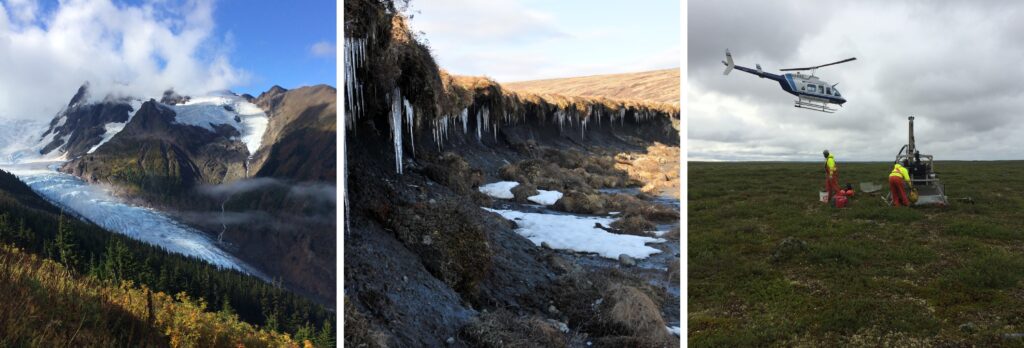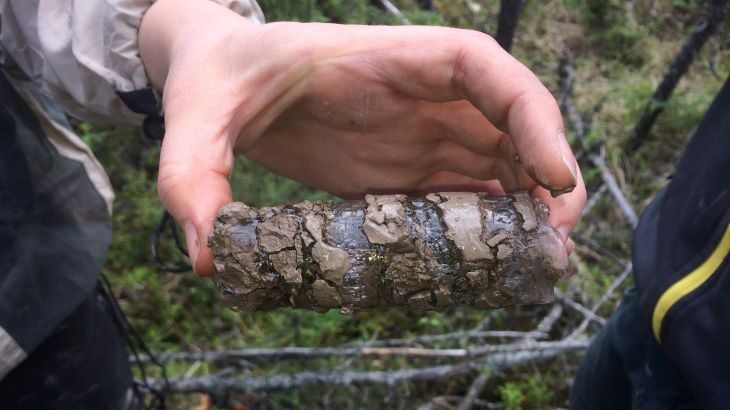By Charles Gauthier, new science communicator
“So, it’s frozen mud?” my roommate asks when I try to explain my research topic to him. Since starting his own research in quantum physics, he has mastered the art of simple idioms. Perks of the trade, I suppose.
This frozen mud, however, covers half of Canada’s land mass. It is the soil on which many Indigenous communities are built, and it is thawing at alarming rates. With northern latitudes warming twice as fast as the rest of the world, scientists are racing to understand permafrost dynamics. Having this knowledge can help us ensure that Canada is equipped to face the coming climate crisis.
What is permafrost and why should we care?
Permafrost is soil that has been frozen for more than two continuous years. What makes it stand out from your ordinary snow bank is that it contains loads of carbon, an element responsible for the greenhouse effect. It is estimated that the world’s permafrost stores about 1700 gigatons of carbon (GtC), or roughly 1700 times the weight of all human beings on the planet. For a sense of scale, global fossil fuel use contributes roughly 10 GtC of emissions each year.
The amount of carbon that permafrost contains is only part of the problem. Unlike the carbon in other types of soils, the carbon in permafrost has often been there, undisturbed, for a very long time. When permafrost thaws, this carbon enters the global carbon cycle from which it has been separated, makes its way to the atmosphere, and eventually contributes to climate change. As temperature rise, more permafrost thaws, kickstarting a vicious cycle that is affecting an ever-growing number of permafrost landscapes around the world.
As if permafrost thawing isn’t a big enough problem in and of itself, scientists believe it could be a possible climate “tipping point.” That is, the thaw of our northern regions may be the first domino to fall in a chain of other, potentially worse, carbon-releasing dominos. Current studies suggest that if we do reach this tipping point, permafrost thaw could become self-perpetuating: a constant source of carbon in an already carbon-loaded system. That’s why climate scientists like me are trying to predict its behaviour—a task that is much harder than it sounds.
Building “puzzles” to predict climate change
Scientists use climate models to simulate the carbon cycle and understand how it is impacted by climate change. Of these models, those dedicated to land ecosystems are called Earth System Models, or ESMs. ESMs are built like giant jigsaw puzzles, with each puzzle piece representing a different aspect of biogeochemical cycles such as water, carbon, energy, snow, or rain. Over the last two decades, scientists have been adding pieces to their ESM puzzles to better represent the complex ways in which the carbon is moving from the atmosphere into soils, such as permafrost, and back. These models also give scientists the opportunity to explore different hypothetical climate scenarios and see how the carbon cycle responds. For example, ESM models have been used to simulate and predict the behaviour of the carbon cycle if global temperatures rise by 2 degrees Celsius, the maximum increase laid out in the 2015 Paris Agreement.
Adding the permafrost piece to the puzzle
Although permafrost likely plays an important role in the global carbon budget, it can be challenging to simulate in climate models. When working on a global scale, scientists often have to settle for a “one size fits all” approach. They sacrifice the small-scale phenomena—the fine details—to better represent general trends. This approach is a problem when it comes to permafrost, which can look very different depending on where you find it. Even though permafrost covers half the country, its defining features such as thickness and carbon concentration can vary every metre.

Permafrost can be found in a variety of landscapes, making it difficult for researchers to characterize using climate models. Photos CC BY-NC-ND 2.0 by PermafrostNet.
This variability leaves scientists like me with a difficult task: how can we add the complex permafrost puzzle piece to our models in a way that represents such a wide range of conditions?
The short answer is: ask nature to do it for you. In my own research, we’re using field data and a process called Bayesian optimization, to ensure the finished “puzzle” we create paints the best possible picture of the reality we’re trying to model.
Bayesian optimization is complex, but the gist is simple. First you gather data, preferably a large quantity of it. Then, you create a starter puzzle—a simple model to get you moving in the right direction. You use this starter model to simulate something that has been measured—say, the carbon content of permafrost soils. Then, you compare your results with the data that you’ve accumulated. If the results differ, you adjust your model—perhaps adding or tweaking a few puzzle pieces—and repeat the process until your results match the real-world observations. In this way, nature acts as the guide, leading the scientist toward the final model.
There’s still a long way to go, but my research team is hopeful that our approach will improve our ability to simulate and understand permafrost’s role in climate change. If we succeed, we’ll be better equipped to predict the changes that lie ahead and to inform decision makers about the climate crisis that is knocking on Canada’s door.
“So, yeah, it is frozen mud,” I tell my roommate. “A very crucial frozen mud.”
Feature image: A permafrost sample collected from a research site 17 km northeast of Yellowknife. Photo CC BY-NC-ND 2.0 by PermafrostNet.
Charles Gauthier is an MSc student at the University of Montreal and a member of NSERC PermafrostNet. His research aims to reduce uncertainty in predicted soil carbon dynamics. He wrote this article as part of Science Borealis’s Winter 2022 Pitch & Polish, a mentorship program that pairs students or researchers with our experienced editors to produce polished pieces of science writing.
Read more about Pitch and Polish
Read other posts by Pitch and Polish students





2 thoughts on “Why frozen mud is a technical challenge for climate scientists”
Comments are closed.